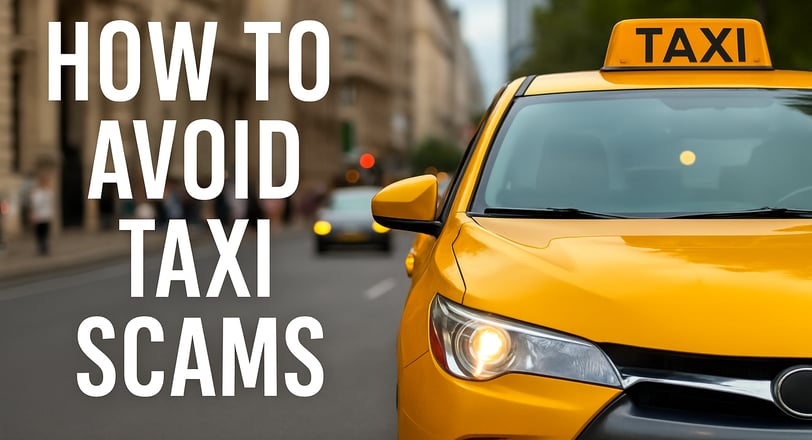🚕 How to Avoid Taxi Scams When Traveling
A Practical Guide for Safer Rides
5/28/20253 min read


Whether you're arriving at a bustling airport, navigating a new city, or simply trying to get from point A to B in a foreign country, taxis can be both a convenience — and a potential trap. While many taxi drivers around the world are honest professionals, taxi scams are one of the most common pitfalls travelers face.
In this post, we’ll walk you through the most frequent taxi frauds and give you clear, practical tips to avoid being overcharged, misled, or worse.
🚨 Common Taxi Scams Travelers Should Watch For
1. The “Broken Meter” Trick
One of the oldest cons in the book: you get in, and the driver suddenly informs you that the meter is “not working.” They then charge an inflated flat rate that’s often double or triple the fair price.
Tip:
Always ask before entering if the meter works. If it doesn't, get out and find another taxi — or negotiate a fixed price before the ride starts.
2. The “Scenic Route” Detour
Also known as the “tourist loop.” The driver takes unnecessarily long or congested routes to increase the fare — banking on your unfamiliarity with the area.
Tip:
Use a map app like Google Maps during the ride. Keep an eye on the route and speak up if it veers off-track. You can even say something like, “Oh, I see the hotel is only 5 minutes away,” just to let them know you’re not clueless.
3. Fake or Unlicensed Taxis
At airports or popular landmarks, scammers drive unlicensed or unofficial cars, posing as taxis. They often overcharge or are connected to more serious risks.
Tip:
Use official taxi ranks at airports or train stations. Always look for official markings (license number, company logo) and check that the meter is visible and functional. In some countries, only certain color taxis are legal.
4. Inflated Currency Conversions
The driver gives you a final fare in the local currency and then charges you in your home currency at an outrageous exchange rate — often through card readers or mobile apps.
Tip:
Pay in local cash when possible. If using a card, double-check the amount before authorizing it and choose to be charged in the local currency, not converted.
5. Switching the Fare at the End
Sometimes the driver will show you a different number than what’s on the meter or claim you misunderstood the fare.
Tip:
Take a photo of the meter display before exiting the car, especially if you sense something off. Don’t be afraid to ask for a receipt (“print receipt” in English is widely understood).
✅ Best Practices for Safe Taxi Travel Anywhere
Use Taxi Apps Whenever Possible
Apps like Uber, Bolt, Grab, DiDi, or FreeNow offer fare transparency, GPS tracking, and dispute support. They’re a safer alternative to street taxis in most cities.Pre-Book Airport Transfers
If you’re arriving in a new country, book a trusted shuttle or transfer through your hotel or a licensed provider. It avoids all the stress right from the start.Ask Locals or Hotel Staff About Fair Prices
They’ll often know what a fair rate is between common destinations — and can sometimes call a reliable taxi for you.Keep Small Bills Handy
Drivers may “not have change” for large notes. Avoid overpaying by keeping small denominations in local currency.Trust Your Gut
If the driver seems evasive, aggressive, or tries to hurry you into the car — walk away. You are never obligated to take a taxi you don’t feel comfortable with.
🌍 Final Thoughts
Getting scammed by a taxi driver can turn a great day into a stressful one. Fortunately, a little awareness goes a long way. By recognizing the red flags and following a few simple practices, you can avoid most taxi scams entirely and focus on what really matters — enjoying your trip.
Travel smart, stay alert, and when in doubt, ask yourself: “Would a local do this?”
Safety
Your guide to secure travel experiences.
Tips
© 2025. All rights reserved.